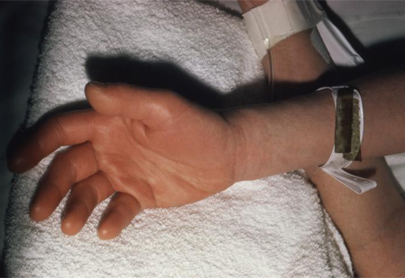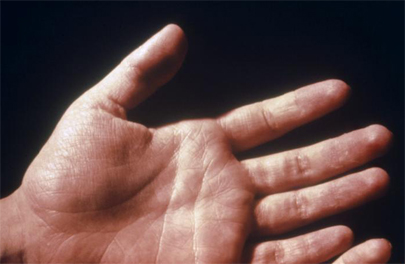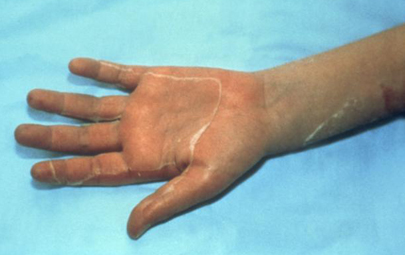History and exam
Key diagnostic factors
common
severe diffuse or localised pain in an extremity
The most common initial presenting symptom in most patients with streptococcal disease. This is typically out of proportion to the examination and associated with evidence of systemic toxicity.
fever
The most common early sign of streptococcal and staphylococcal disease, although hypothermia can be seen in patients with shock.[63]
localised swelling or erythema
Clinical signs of local tissue infection are seen in 80% of patients with streptococcal infections, and 70% of these have subsequent ecchymoses, skin sloughing, and, finally, myositis and necrotising fasciitis.[41] Gangrene may also develop.
Diffuse erythroderma involving the skin and mucous membranes may develop within the first 48 hours in staphylococcal disease, particularly of the palms and soles. In postoperative staphylococcal disease, the erythema is often more severe around the surgical wound site, though it may be subtle. In more severe staphylococcal cases, ulcerations, vesicles, and bullae can develop.[Figure caption and citation for the preceding image starts]: Rash and subcutaneous oedema of the right hand due to toxic shock syndromeFrom the CDC and the Public Health Image Library [Citation ends]. [Figure caption and citation for the preceding image starts]: Patient with facial erythematous rash due to toxic shock syndromeFrom the CDC and the Public Health Image Library [Citation ends].
[Figure caption and citation for the preceding image starts]: Patient with facial erythematous rash due to toxic shock syndromeFrom the CDC and the Public Health Image Library [Citation ends].
hypotension
In streptococcal and staphylococcal infections, half of all patients may be normotensive on admission but develop hypotension in the subsequent 4 to 8 hours.[63]
Hypotension reflects hypovolaemia, hypoperfusion, and/or severe sepsis with massive cytokine release by the toxins.
uncommon
diffuse, scarlatina-like erythematous rash
Seen in 10% patients with streptococcal disease, usually initially of an extremity.[68] Rash may desquamate later.[2]
In staphylococcal disease, the maculopapular rash desquamates in 1 to 2 weeks and is often seen initially on the palms and soles. [Figure caption and citation for the preceding image starts]: Subtle desquamation of the finger tips of the left hand caused by toxic shock syndromeFrom the CDC and the Public Health Image Library [Citation ends]. [Figure caption and citation for the preceding image starts]: Patient displaying a morbilliform rash (resembling measles) resulting from toxic shock syndrome, 3 to 5 days after onsetFrom the CDC and the Public Health Image Library [Citation ends].
[Figure caption and citation for the preceding image starts]: Patient displaying a morbilliform rash (resembling measles) resulting from toxic shock syndrome, 3 to 5 days after onsetFrom the CDC and the Public Health Image Library [Citation ends]. [Figure caption and citation for the preceding image starts]: Marked desquamation of the left palm due to toxic shock syndrome, which develops late in the diseaseFrom the CDC and the Public Health Image Library [Citation ends].
[Figure caption and citation for the preceding image starts]: Marked desquamation of the left palm due to toxic shock syndrome, which develops late in the diseaseFrom the CDC and the Public Health Image Library [Citation ends].
Other diagnostic factors
common
acute mental status changes
Signs of cerebral hypoperfusion and oedema with subsequent confusion, agitation, and change in level of consciousness can occur in both streptococcal and staphylococcal infections.
uncommon
influenza-like symptoms
Chills, myalgias, nausea, vomiting, and diarrhoea are present in 20% at presentation.[68]
muscular tenderness and weakness
Features of myositis.
gastrointestinal symptoms
Part of a range of symptoms seen in patients with streptococcal and staphylococcal infections who do not present with soft-tissue findings.
Patients may present with severe abdominal pain with rebound tenderness and guarding on abdominal examination. Nausea, vomiting, and diarrhoea may be present; associated with toxin production.
features of myocarditis
Part of a range of symptoms seen in patients with streptococcal and staphylococcal infections who do not present with soft-tissue findings.
Symptoms may include chest pain, dyspnoea, orthopnoea, syncope, fatigue, and palpitations.
Findings can include signs of cardiac failure, tachycardias, or arrhythmias.
endophthalmitis
Part of a range of symptoms seen in patients with streptococcal and staphylococcal infections who do not present with soft-tissue findings.
hypothermia
Fever is the most common early sign of streptococcal and staphylococcal disease, although hypothermia can be seen in patients with shock.[63]
Risk factors
strong
diabetes mellitus
Associated with an increased risk: in a surveillance study performed over 1 year in 4 US states, 21.6% of patients with streptococcal toxic shock syndrome (TSS) had diabetes.[62]
alcohol-use disorder
Associated with an increased risk: in a surveillance study performed over 1 year in 4 US states, 16.8% of patients with streptococcal TSS reported alcohol misuse.[62]
minor trauma and injuries with bruising, haematoma formation, or muscle strain
Serve as a portal of entry and predispose to infection.[63]
surgical procedures (e.g., vaginal delivery, breast reconstruction, caesarean section, hysterectomy, liposuction, bunionectomy)
prolonged use (>6 hours) of single tampon
Menstrual staphylococcal TSS is associated with tampon use over 6 hours, overnight use, and failing to follow tampon insertion instructions.[70][71]
Tampon use does not increase the likelihood of staphylococcal colonisation but increases the risk of staphylococcal TSS by enhancing the production of TSS toxin-1 (TSST-1).
using highly absorbent tampons
Although highly absorbent tampons have been withdrawn from the market, tampon use remains a risk factor for staphylococcal TSS.[4][72][73]
Tampons containing glycerol monolaurate (GML) reduce Staphylococcus aureus exotoxin production. Studies suggest that GML added to tampons provides additional safety relative to menstrual toxic shock.[74]
weak
non-steroidal anti-inflammatory drug (NSAID) use
using contraceptive sponges, diaphragms, and IUDs
May be risk factors for non-menstrual staphylococcal TSS.[23]
untreated strep throat
TSS is a rare complication of streptococcal pharyngitis (strep throat) in adults.[76] Household contacts of young children with group A streptococcal infection are at increased risk of infection.[31] Patients with confirmed strep throat should follow national recommendations to prevent transmission. The Centers for Disease Control and Prevention (CDC) in the US recommends that patients stay at home (from work, school, or daycare) until they are afebrile and at least 12-24 hours after commencing antibiotic treatment.[77] UK guidance recommends that patients with strep throat isolate for at least 24 hours after the start of treatment with an appropriate antibiotic.[78]
Use of this content is subject to our disclaimer